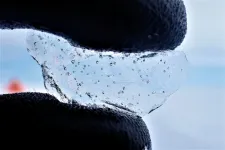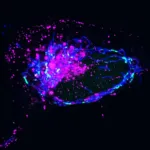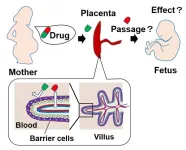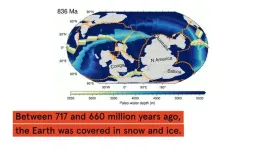(Press-News.org) Researchers from the University of Cambridge and the British Antarctic Survey have uncovered the first direct evidence that the West Antarctic Ice Sheet shrunk suddenly and dramatically at the end of the Last Ice Age, around eight thousand years ago.
The evidence, contained within an ice core, shows that in one location the ice sheet thinned by 450 metres — that’s more than the height of the Empire State Building — in just under 200 years.
This is the first evidence anywhere in Antarctica for such a fast loss of ice. Scientists are worried that today’s rising temperatures might destabilize parts of the West Antarctic Ice Sheet in the future, potentially passing a tipping point and inducing a runaway collapse. The new study, published in Nature Geoscience, sheds light on how quickly Antarctic ice could melt if temperatures continue to soar.
“We now have direct evidence that this ice sheet suffered rapid ice loss in the past,” said Professor Eric Wolff, senior author of the new study from Cambridge’s Department of Earth Sciences. “This scenario isn’t something that exists only in our model predictions and it could happen again if parts of this ice sheet becomes unstable.”
The Antarctic ice sheets, from west to east, contain enough freshwater to raise global sea levels by around 57 metres. The West Antarctic Ice Sheet is considered particularly vulnerable because much of it sits on bedrock that lies below sea level.
Model predictions suggest that a large part of the West Antarctic Ice Sheet could disappear in the next few centuries, causing sea levels to rise. Exactly when and how quickly the ice could be lost is, however, uncertain.
One way to train ice sheet models to make better predictions is to feed them with data on ice loss from periods of warming in Earth’s history. At the peak of Last Ice Age 20,000 years ago, Antarctic ice covered a larger area than today. As our planet thawed and temperatures slowly climbed, the West Antarctic Ice Sheet contracted to more or less its current extent.
“We wanted to know what happened to the West Antarctic Ice Sheet at the end of the Last Ice Age, when temperatures on Earth were rising, albeit at a slower rate than current anthropogenic warming,” said Dr Isobel Rowell, study co-author from the British Antarctic Survey. “Using ice cores we can go back to that time and estimate the ice sheet’s thickness and extent.”
Ice cores are made up of layers of ice that formed as snow fell and was then buried and compacted into ice crystals over thousands of years. Trapped within each ice layer are bubbles of ancient air and contaminants that mixed with each year’s snowfall — providing clues as to the changing climate and ice extent.
The researchers drilled a 651-metre-long ice core from Skytrain Ice Rise in 2019. This mound of ice sits at the edge of the ice sheet, near the point where grounded ice flows into the floating Ronne Ice Shelf.
After transporting the ice cores back to Cambridge at -20oC, the researchers analysed them to reconstruct the ice thickness. First, they measured stable water isotopes, which indicate the temperature at the time the snow fell. Temperature decreases at higher altitudes (think of cold mountain air), so they were able to equate warmer temperatures with lower-lying, thinner ice.
They also measured the pressure of air bubbles trapped in the ice. Like temperature, air pressure also varies systematically with elevation. Lower-lying, thinner ice contains higher pressure air bubbles.
These measurements told them that ice thinned rapidly 8,000 years ago. “Once the ice thinned, it shrunk really fast,” said Wolff, “this was clearly a tipping point — a runaway process.”
They think this thinning was probably triggered by warm water getting underneath the edge of the West Antarctic Ice Sheet, which normally sits on bedrock. This likely untethered a section of the ice from bedrock, allowing it to float suddenly and forming what is now the Ronne Ice Shelf. This then allowed neighbouring Skytrain Ice Rise, no longer restrained by grounded ice, to thin rapidly.
The researchers also found that the sodium content of the ice (originating from salt in sea spray) increased about 300 years after the ice thinned. This told them that, after the ice thinned, the ice shelf shrunk back so that the sea was hundreds of kilometres nearer to their site.
“We already knew from models that the ice thinned at around this time, but the date of this was uncertain,” said Rowell. Ice sheet models placed the retreat anywhere between 12,000 and 5,000 years ago and couldn’t say how quickly it happened. “We now have a very precisely dated observation of that retreat which can be built into improved models,” said Rowell.
Although the West Antarctic Ice Sheet retreated quickly 8,000 years ago, it stabilized when it reached roughly its current extent. “It’s now crucial to find out whether extra warmth could destabilize the ice and cause it to start retreating again,” said Wolff.
END
Ice cores provide first documentation of rapid Antarctic ice loss in the past
2024-02-08
ELSE PRESS RELEASES FROM THIS DATE:
Faulty DNA disposal system causes inflammation
2024-02-08
LA JOLLA (February 8, 2024)—Cells in the human body contain power-generating mitochondria, each with their own mtDNA—a unique set of genetic instructions entirely separate from the cell’s nuclear DNA that mitochondria use to create life-giving energy. When mtDNA remains where it belongs (inside of mitochondria), it sustains both mitochondrial and cellular health—but when it goes where it doesn’t belong, it can initiate an immune response that promotes inflammation.
Now, Salk scientists ...
Breaking through barriers
2024-02-08
Researchers from Tokyo Medical and Dental University (TMDU) overcome scientific roadblocks and develop a model to assess the biology of the human placental barrier
Tokyo, Japan – During pregnancy, the human placenta plays multiple essential roles, including hormone production and nutrient/waste processing. It also serves as a barrier to protect the developing fetus from external toxic substances. However, the placental barrier can still be breached by certain drugs. In a recent article published in Nature Communications, a team led by researchers ...
Patterns of brain connectivity differ between pre-term and term babies
2024-02-08
Under strict embargo until 10.00 GMT Thursday 8 February 2024
A new King’s College London scanning study of 390 babies has shown distinct patterns between term and pre-term babies in the moment-to-moment activity and connectivity of brain networks.
Supported by Wellcome and the National institute of Health and Care Research (NIHR) Maudsley Biomedical Research Centre, this is the first study to analyse how the communication between brain areas changes moment-to-moment in the first few weeks of life.
Published in Nature Communications, the study also found that these dynamic ...
Social science: White actors featured more than non-white actors on American film posters
2024-02-08
White actors are featured more frequently and more prominently on posters for American-produced films than non-white actors despite recent increases in the representation of actors from other ethnic groups, according to a study published in Humanities and Social Sciences Communications.
Galit Fuhrmann Alpert and colleagues investigated trends in the ethnic diversity of actors featured on over 45,000 posters advertising over 24,000 English-speaking films produced in the USA between 1960 and 2021. Actors were assigned to one of four ethnic groups; white, Black, Indian, or Asian using an algorithm trained on the FairFace image dataset, which contains equal numbers ...
Researchers identify potential way to treat genetic epilepsy by replacing ‘lost’ enzyme
2024-02-08
Francis Crick Institute press release
Under strict embargo: 01:00hrs GMT Thursday 8 February 2024
Peer reviewed
Experimental study
Animals and cells
Researchers identify potential way to treat genetic epilepsy by replacing ‘lost’ enzyme
Scientists at the Francis Crick Institute have found a new treatment target for CDKL5 deficiency disorder (CDD), one of the most common types of genetic epilepsy.
CDD causes seizures and impaired development in children, and medications are limited to managing symptoms rather than tackling the root cause of the disease. The disorder involves losing the function of a gene producing the CDKL5 enzyme, which ...
New guidelines for reporting clinical trials of biofield therapies
2024-02-08
New guidelines for reporting clinical trials of biofield therapies are presented in the peer-reviewed Journal of Integrative and Complementary Medicine (JICM). Biofield therapies (BFTs), such as External Qigong, Healing Touch, Reiki, and Therapeutic Touch, are a related group of integrative medicine interventions in which practitioners use their hands on or above a client’s body to stimulate healing and well-being. Click here to read the article now.
The guidelines call for including details of the intervention protocols relevant to biofield therapy trials. The Reporting Evidence Guidelines comprises ...
Wayne State University awarded $1.4 million from Department of Defense to expand on research findings surrounding prostate cancer
2024-02-08
DETROIT– A team of researchers from Wayne State University was awarded a $1.4 million, three-year grant from the U.S. Department of Defense for the study, “Cytochrome c acetylation drives prostate cancer aggressiveness and Warburg effect.”
The study, led by Maik Hüttemann, Ph.D., professor of molecular medicine and genetics, and biochemistry, microbiology and immunology at Wayne State University’s School of Medicine, aims to establish the role of the protein cytochrome c, which the team proposes is ...
What turned Earth into a giant snowball 700m years ago? Scientists now have an answer
2024-02-08
Australian geologists have used plate tectonic modelling to determine what most likely caused an extreme ice-age climate in Earth’s history, more than 700 million years ago.
The study, published in Geology, helps our understanding of the functioning of the Earth's built-in thermostat that prevents the Earth from getting stuck in overheating mode. It also shows how sensitive global climate is to atmospheric carbon concentration.
“Imagine the Earth almost completely frozen over,” said the study’s lead author, ARC Future Fellow ...
Researchers estimate survival chances during CPR for cardiac arrest
2024-02-08
A person’s chance of surviving while receiving cardiopulmonary resuscitation (CPR) for cardiac arrest in hospital declines rapidly from 22% after one minute to less than 1% after 39 minutes, finds a US study published by The BMJ today.
Similarly, the likelihood of leaving hospital with no major brain damage declines from 15% after one minute of CPR to less than 1% after 32 minutes with no heartbeat.
The researchers say the findings provide insights that may help guide hospital teams, patients and their families in deciding how long to continue resuscitation.
In-hospital ...
Group rehabilitation improves quality of life for people with long covid
2024-02-08
An online programme of physical and mental health rehabilitation can improve quality of life for adults with long covid, finds a trial published by The BMJ today.
The eight week REGAIN programme, delivered in online group sessions, led to sustained improvements in fatigue, pain, and depression compared with usual care.
The researchers say this accessible, resource-efficient programme can be delivered at scale and will assist clinicians in the treatment of this complex condition.
Post-covid-19 condition (commonly known as long covid) ...







